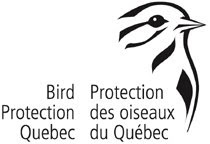Surprisingly ten people showed up for yesterday's field trip to Rigaud Mountain considering the drizzly, damp, cool conditions which really didn't let up for most of the morning. The breeze, the pitter-patter of rain on leaves and a few of the strange Rigaud Mountain bird dialects made a few identifications by ear difficult. The upside was that temperatures which never went above 15°C meant that the mosquitoes and deer flies were kept to a minimum.
We spent the morning exploring a trail from L'Erabliere St Henri northward to Lac des Castors. Not a long walk but it covers some interesting forested habitat with small clearings interspersed. The small lake at the end is difficult to see because the surrounding vegetation has grown up over the last few years but we were able to see a three great blue heron nests, one of which was occupied. It does seem that the number of nests is significantly reduced from previous years probably due to the dead trees in which they were located having fallen into the pond.
Most of the area we covered is now within a 110 hectare area under the protection of Nature-Action Québec.
Our highlight of the day was a singing Mourning Warbler who stayed in one place for several minutes while we watched. Two American Kestrels were also noteworthy as they put on an aerial display near the parking lot on our way out. They seemed to have a nest in the immediate vicinity although we could not discover exactly where.
Our complete list of 41 species seen and/or heard includes: Canada Goose (Bernache du Canada) - 3, Great Blue Heron (Grand Héron) - 1, American Kestrel (Crécerelle d'Amérique) - 2, Rock Pigeon (Pigeon Biset) - 1, Mourning Dove (Touterelle Triste) - 2, Belted Kingfisher Martin (Pêcheur d'Amerique) - 1, Yellow-bellied Sapsucker (Pic Maculé) - 4, Eastern Wood-Pewee (Piou de l'Est) - 4, Alder Flycatcher (Moucherolle des Aulnes) - 2, Least Flycatcher (Moucherolle tchébec) - 2, Eastern Phoebe (Moucherolle Phébi) - 1, Great-crested Flycatcher (Tyran Huppé) - 2, Eastern Kingbird (Tyran tritri) - 1, Warbling Vireo (Viréo mélodieux) - 1, Red-eyed Vireo (Viréo aux yeux rouges) - 7, Blue Jay (Geai Bleu) - 6, American Crow (Corneille d'Amérique) - 4, Common Raven (Grand Corbeau) - 1, Black-capped Chickadee (Mésange à tête noire) - 3, Veery (Grive fauve) - 8, Wood Thrush (Grive des bois) - 1, Gray Catbird (Moqueur Chat) - 2, European Starling (Étourneau sansonnet) - 2, Cedar Waxwing (Jaseur d'Amérique)- 10, Chestnut-sided Warbler (Paruline à Flancs Marron) - 12, Black-throated Blue Warbler (Paruline Bleue) - 4, Black-and-white Warbler (Paruline Noir et Blanc) - 3, American Redstart (Paruline Flamboyante) - 1, Ovenbird (Paruline Couronnée) - 6, Mourning Warbler (Paruline Triste) - 1, Common Yellowthroat (Paruline Masquée) - 3, Chipping Sparrow (Bruant Familier) - 1, Song Sparrow (Bruant Chanteur) - 8, Swamp Sparrow (Bruant des Marais) - 2, White-throated Sparrow (Bruant à Gorge Blanche) - 5, Rose-breasted Grosbeak (Cardinal à poitrine rose) - 3, Indigo Bunting (Passerin Indigo) - 1, Red-winged Blackbird (Carouge à Épaulettes) - 12, Common Grackle (Quiscale Bronzé) - 6, Brown-headed Cowbird (Vacher à Tête Brun) - 1, American Goldfinch (Chardonneret Jaune) - 6
Thanks to everyone for an enjoyable if damp morning. - Wayne Grubert
Sunday, June 09, 2013
Subscribe to:
Post Comments (Atom)





No comments:
Post a Comment